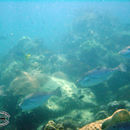Diagnostic Description
provided by Fishbase
Rudimentary pelvic spine disappears in large specimen (Ref. 36453). Snout convex in adults (Ref. 1602). Sandy to grey with small brown spots above; soft dorsal and anal fins pale yellowish to brownish; caudal membrane blackish brown (Ref. 4421).Description: Characterized further by juveniles having reticulate pattern of pale lines and grey blotches; convex dorsal and ventral profiles of head; terminal mouth; snout much longer than caudal fin; depth of body at anal fin origin 2.5-2.8 in SL (Ref. 90102).
- Recorder
- Cristina V. Garilao
Life Cycle
provided by Fishbase
Distinct pairing (Ref. 205).
Morphology
provided by Fishbase
Dorsal spines (total): 2; Dorsal soft rays (total): 45 - 52; Analspines: 0; Analsoft rays: 47 - 53
- Recorder
- Cristina V. Garilao
Trophic Strategy
provided by Fishbase
Occasionally in shallow water by steep drop-offs. Solitary or in pairs, occasionally in groups of five or six, at less than 10 m depth. Juveniles are pelagic, seen under floating objects (Ref. 9318, 48637). Benthopelagic (Ref. 58302). Adults and juveniles are rarely seen near reefs. Juveniles are pelagic, seen under floating objects (Ref. 9318). Juveniles often with large jellies and these may bring them close to reefs and adults may nest on sandflats adjacent to reefs in deep water. At other times, the adults may form large schools under weed-rafts that usually form during the wet season (Ref. 48637). Feed on benthic organisms (Ref. 30573).
- Recorder
- Drina Sta. Iglesia
Biology
provided by Fishbase
Occasionally in shallow water by steep drop-offs. Solitary or in pairs, occasionally in groups of five or six, at less than 10 m depth. Juveniles are pelagic, seen under floating objects (Ref. 9318, 48637). Benthopelagic (Ref. 58302). Adults and juveniles are rarely seen near reefs. Juveniles often with large jellies and these may bring them close to reefs and adults may nest on sandflats adjacent to reefs in deep water. At other times, the adults may form large schools under weed-rafts that usually form during the wet season (Ref. 48637). Feed on benthic organisms (Ref. 30573).
Importance
provided by Fishbase
fisheries: commercial

